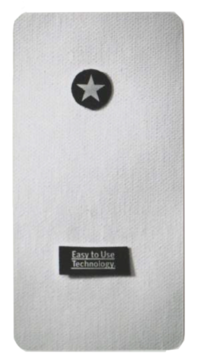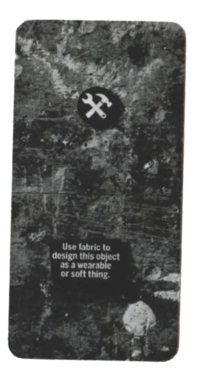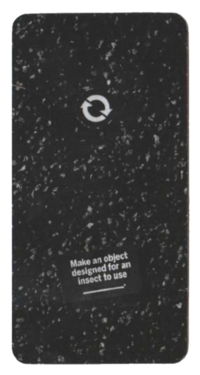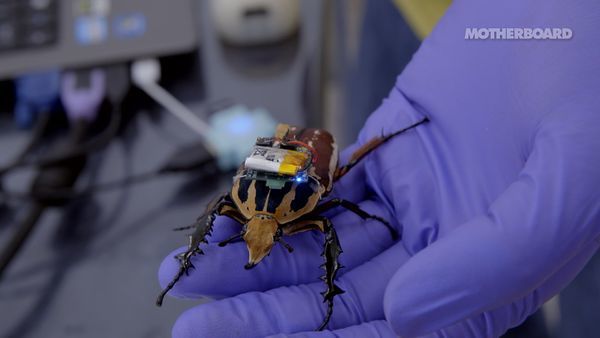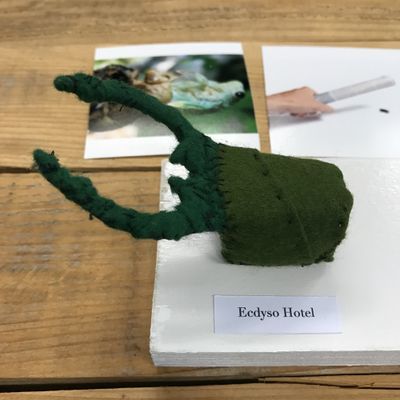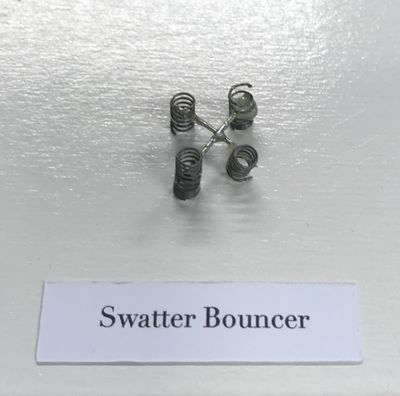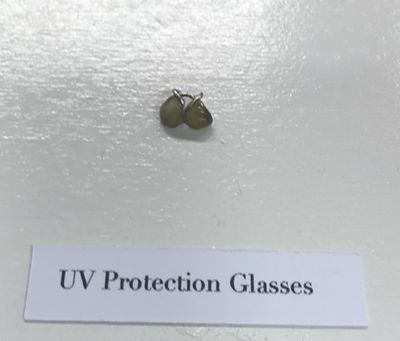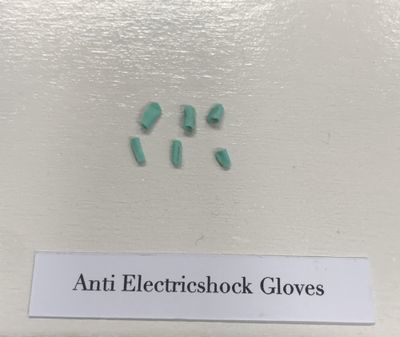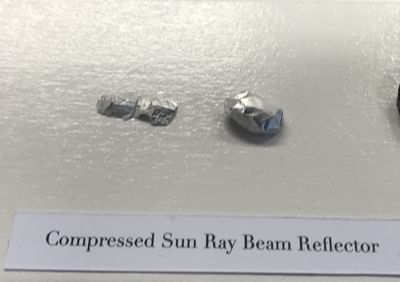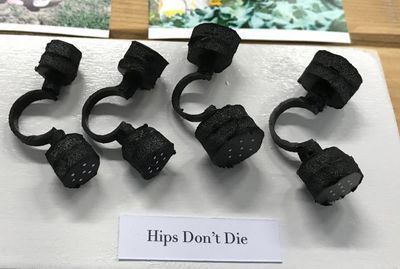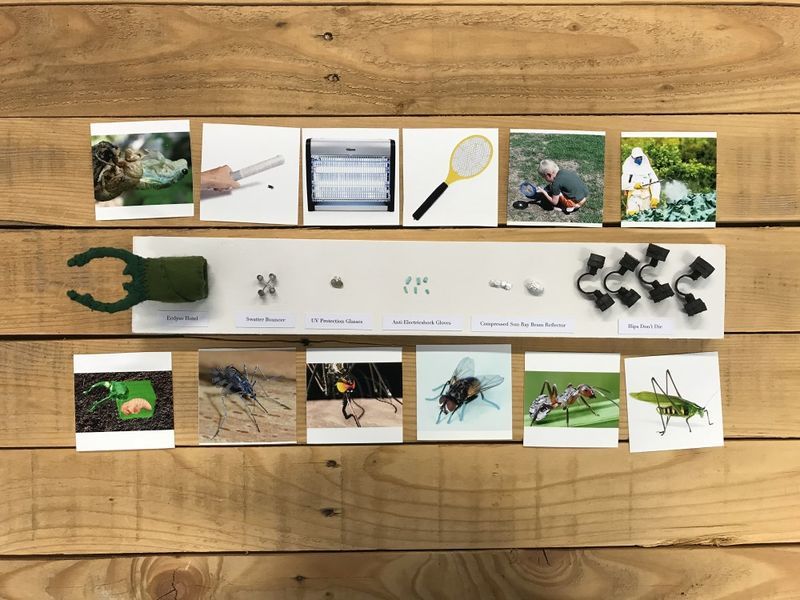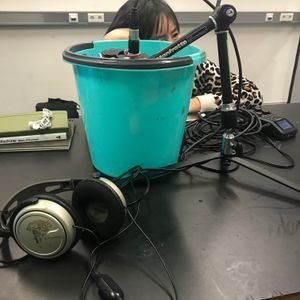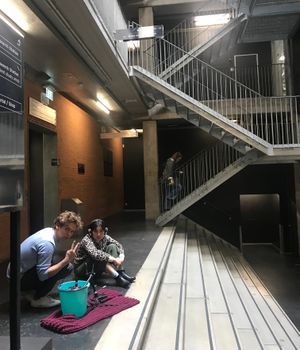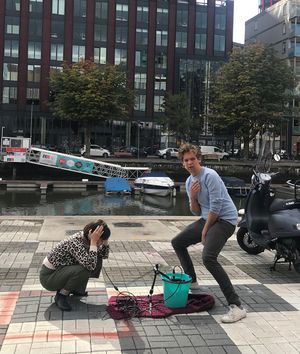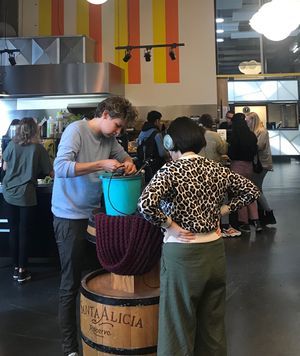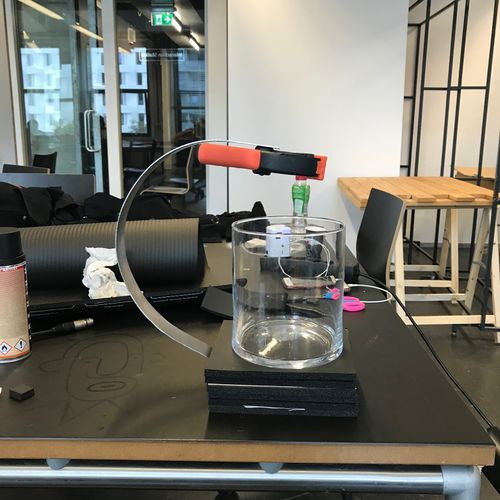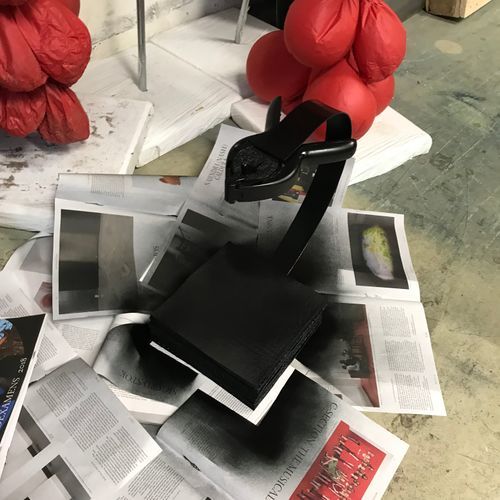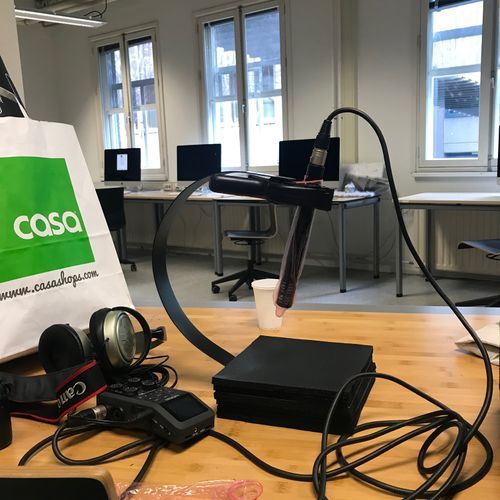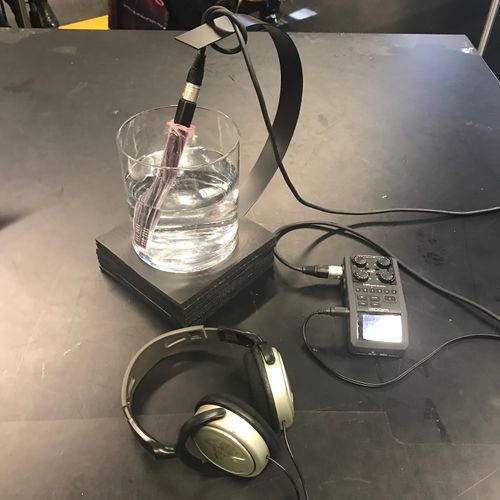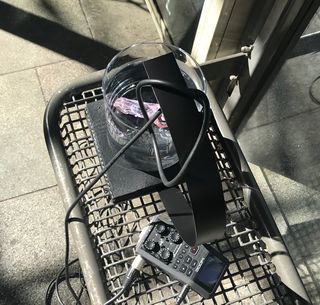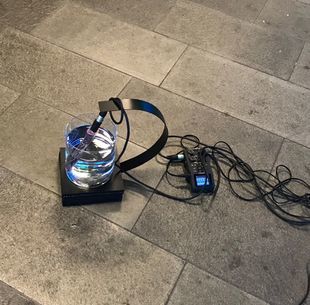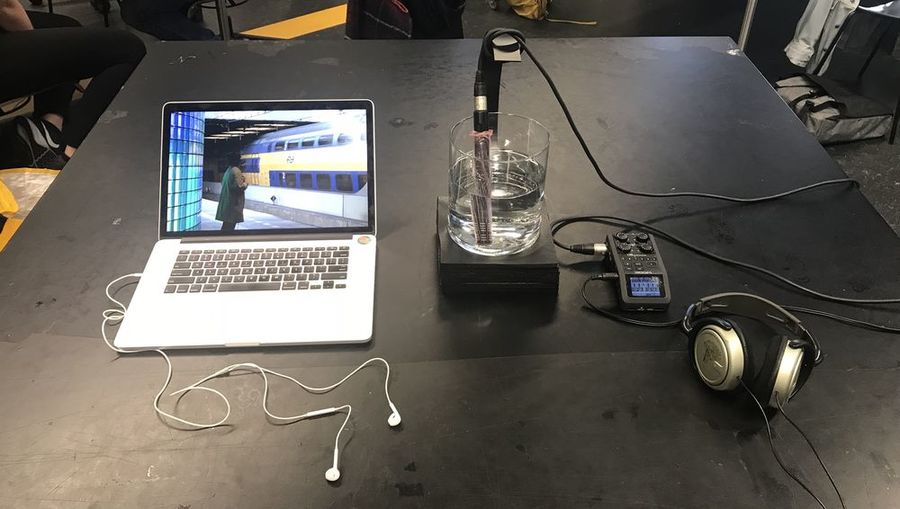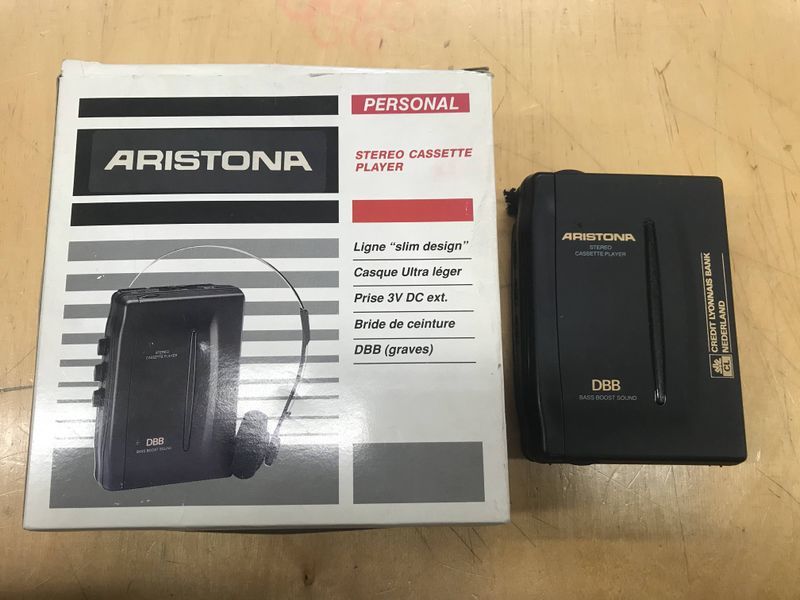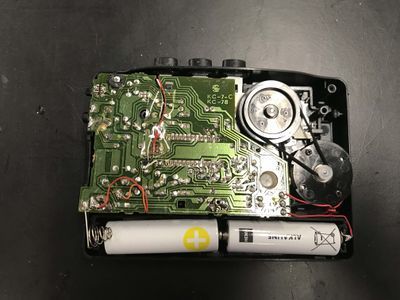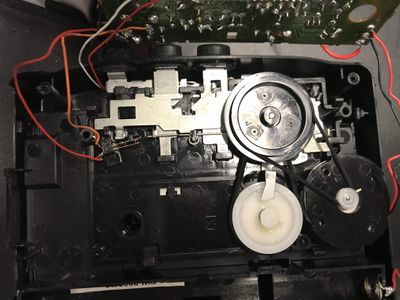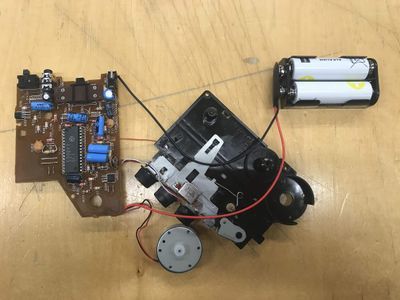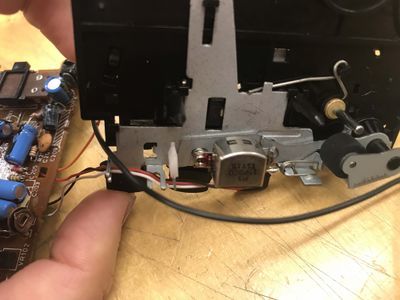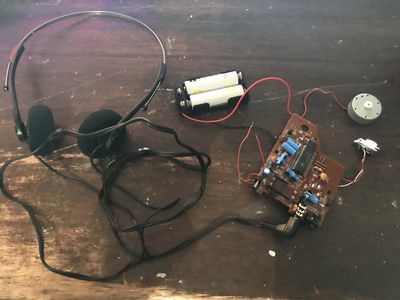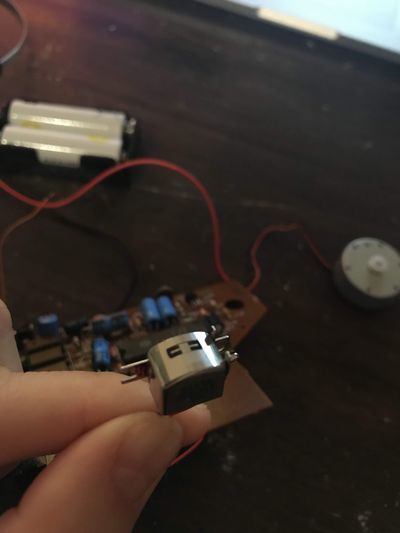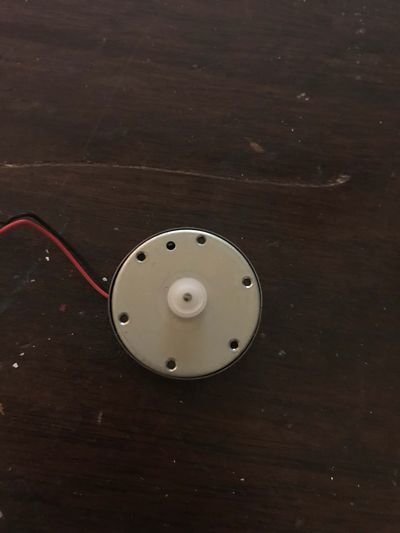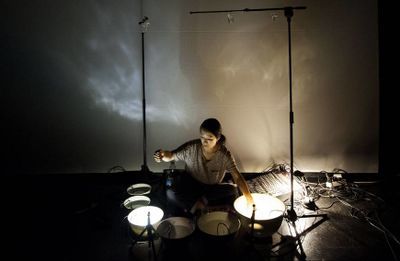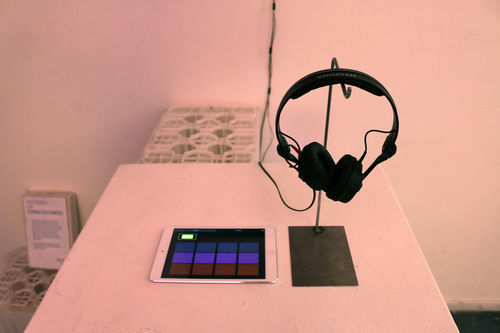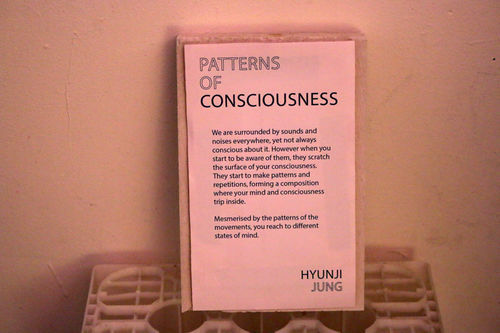Difference between revisions of "Digital Craft Minor 4th Year: Cybernetics"
| (231 intermediate revisions by the same user not shown) | |||
| Line 27: | Line 27: | ||
[[File:Insectoverview.jpg | 800px]] | [[File:Insectoverview.jpg | 800px]] | ||
| + | <br><br><br><br><br><br><br><br><br><br><br><br><br><br><br><br><br><br><br><br> | ||
=Project 2: Cybernetic Prosthetics= | =Project 2: Cybernetic Prosthetics= | ||
| − | + | ==Starting Point== | |
| + | Our first inspiration from nature, as a biomimicry was how whales communicate underwater. They communicate ultrasonic sound. | ||
===Research=== | ===Research=== | ||
| − | + | There were several interesting facts on how whales communicate and various examples how the ultrasonic can be used in real world. | |
| + | ===Insight from Research=== | ||
| + | However, we could not really drag one new idea we can work on derived from ultrasonic. We were watching some youtube video with whale sound and found that it is actually used for calming effect, and meditation usage. From this, we were thinking it would be nice to actually feel and hear as if we were under the sea. What if we make a device transform our surrounding to underwater by means of sound? | ||
| + | ==Plan== | ||
| + | We decided to use a hydrophone, a jar, and a recorder with which we can hear the input directly monitored to the headphone. However a hydrophone was too expensive, so we asked Rob in Image and Sound station and he recommended us to cover a regular microphone with a condom. | ||
===First Testing=== | ===First Testing=== | ||
| Line 57: | Line 63: | ||
[[File:IMG 8785.jpg|1000px]] | [[File:IMG 8785.jpg|1000px]] | ||
| + | |||
| + | <br><br><br><br><br><br><br><br><br><br><br><br><br><br><br><br><br><br><br><br> | ||
=Project 3: From Devices to systems= | =Project 3: From Devices to systems= | ||
Cassette recorder to Electromagnetic noise detector | Cassette recorder to Electromagnetic noise detector | ||
| + | https://electronics.howstuffworks.com/gadgets/audio-music/cassette2.htm | ||
[[File:Tapehead_00.jpg|800px]] <br> | [[File:Tapehead_00.jpg|800px]] <br> | ||
| Line 70: | Line 79: | ||
[[File:Tapehead_06.jpg|400px]] [[File:Tapehead_07.jpg|400px]] | [[File:Tapehead_06.jpg|400px]] [[File:Tapehead_07.jpg|400px]] | ||
| − | + | <br><br><br><br><br><br><br><br><br><br><br><br><br><br><br><br><br><br><br><br> | |
| − | =Final Project (RESEARCH DOCUMENT)= | + | =<span style="color: blueviolet">Final Project (RESEARCH DOCUMENT)= |
[[Position Paper_H Jung]] | [[Position Paper_H Jung]] | ||
| − | ==Introduction== | + | ==<span style="color: #14DFC4">Introduction== |
| − | + | Extended from my former study English Language and Literature, I experiment with postmodern literary ideas in my works, such as stream of consciousness, fragmentation, and non-narrativity. I have been experimenting with different media, mainly photography, text, and sculpture. They demonstrate my perception of memory, time, and narrative, either linear or non linear. I interpret them as my trial to understand how we, as human beings, are conscious of ourselves, and surroundings to define our existence. I try to capture how I am conscious with my surroundings and intrigue audiences to question their own. Therefore, physicality, in terms of being present in the moment at the surrounding, and immersion into real space became my main subject matter. My work is about providing an environment by sending an invitation to audiences to be in the moment with the artwork. However, my work has been more of presenting art objects which derived from my own experience and has narratives behind. Since I become more aware of my recurring theme, I am eager to find the most effective way to express my contemplation. The immersive effect of new media technology is very powerful and brought us new consciousness in our daily lives. I want to make use of new media technology to provide audiences immersive effects and question the meaning of being conscious, mindful in reality at the same time. My current interest is the immersive effect of sound and video, also when they are combined. | |
| − | I | + | ==<span style="color: #14DFC4">Research Question== |
| + | Sound is the most immediate and immersive media to me. It is abstract yet very tangible and physical at the same time. We respond on in directly which I conceive as a bodily reaction. Therefore, my starting point of this project was 'sound' which developed into making use of sound for an interactive installation to make people conscious of their surroundings combined with other new media technologies. Sound has been my all time biggest interest. I have been always fascinated by weird noise and electronic music. Therefore I decided to research on digital audio processing and how to produce electronic music. Besides, I chose to do something has to do with audio for the former exercises to narrow down which aspects and elements of sound I want to further develop specifically. In exercise 2, as a group, we made a device to experience being underwater, using water as an analogue sound filter for surrounding. In exercise 3, I dissembled a tape player and transformed it into an electromagnetic noise detector using the tape head reads sound when it was close to magnetic. From exercise 2 and 3, I dragged my research topic as our perception of sound around us. I pointed the hypnotising and meditating effect of sound since it brings us to another state of mind/consciousness. I also wanted to identify myself what is the border between sound art and music. Therefore, my research question became “How do we perceive sound around us? How does it affect our consciousness?” | ||
| − | + | ==<span style="color: #14DFC4">Research Approach== | |
| − | + | My research process is mainly divided into two parts. Firstly, I read much literatures and information to find some interesting and relevant feature to me from the broad context and then narrow down to few things from which I would develop further, connecting them to do some practical exercises. Second, I do practical research on certain material, methodologies, skills by working on them. This two researches can go back and forth since I actually always come across with unexpected features and have new idea by doing practical research. It never really worked out as I assumed with theoretical and thought research, and the conclusion has always changed. Therefore, I would like to keep my research question open, but still limiting the main theme since I can be lost easily from too broad context and topics. By keeping the research question open, I can analyse the process and formulate rather specific questions inside. At the beginning of this project, I didn't know which elements and aspects of sound I wanted to further work on yet. However from the exercises I dragged my research question as "How we perceive sound around us and how does it affect us?" From this point, I will do more experiments extended from the former exercise of using hydrophone water as an analogue filter. From this, I will figure out if it works. If it doesn't, at least I know what works and not and there should be some other aspects come up afterwards, for instance from the contact microphone or the material and size of the jar, etc. | |
| − | |||
| − | |||
| − | |||
| − | |||
| − | ==Research | ||
| − | |||
| − | |||
| − | |||
| − | |||
| − | |||
| − | |||
| − | |||
| − | |||
| − | |||
| − | |||
| − | |||
| − | |||
| + | ==<span style="color: #14DFC4">Inspiration/Reference== | ||
| + | Sound art, using sound as an art medium, has been explored a lot in last decades. There are also many well-known and overlapping terms such as Experimental music, Avant-garde music, Electroacoustic music etc. To contextualise my topic in contemporary art, I researched the relevant history of Experimental music and Sound art, and practitioners to whom I can relate. I am quite familiar with the history of Electronic music (Dance music especially) so it was interesting to make connection between them. | ||
| + | <br><br> | ||
===Historical context=== | ===Historical context=== | ||
====Electroacoustic Music==== | ====Electroacoustic Music==== | ||
| + | Electroacoustic music is a style of Western art music which originated around the middle of the 20th century, following the incorporation of electric sound production into compositional practice. <ref>https://en.wikipedia.org/wiki/Electroacoustic_music</ref> All electroacoustic music is made with electronic technology, specifically a device, usually a loudspeaker, that transduce electrical energy to acoustic energy. I found this relevant to my practice since I wanted to combine electronic sound with physical, acoustic elements. Tape music was an integral part of electroacoustic music and I always wanted to try it since all digital sampling, editing techniques came from analogue tape manipulation. Tape music utilises pre-recorded fragments, loops, and sampled sounds, altering and manipulating them through techniques such as speed manipulation. In the context of electroacoustic music from the past, I found the artists John Cage and Pierre Schaeffer as references to my practice. | ||
| + | <br><br> | ||
====John Cage==== | ====John Cage==== | ||
| − | Indeterminacy in music | + | [[file:john-cage.jpg|left||thumb|250px|Image source: https://www.newyorker.com/magazine/2010/10/04/searching-for-silence]] |
| + | John Cage was an American composer and music theorist. Cage was one of the leading, the most influential figures of the post-war avant-garde, lauded as one of the most influential composers of the 20th century. I know him from his best known composition work 4′33″ from 1952, which is performed in the absence of deliberate sound. Musicians who present the work do nothing aside from being present for the duration specified by the title. The content of the composition is not the silence of the duration, but rather the sounds of the environment heard by the audience during performance. The work's challenge to assumed definitions about musicianship and musical experience made it a popular and controversial topic both in musicology and the broader aesthetics of art and performance.<ref>https://en.wikipedia.org/wiki/John_Cage</ref> This concept of <em>Indeterminacy</em> in music is a composing approach in which some aspects of a musical work are left open to chance or to the interpreter's free choice.<ref>https://en.wikipedia.org/wiki/Indeterminacy_(music)</ref> | ||
| + | I didn't know about 'prepared piano' before but it also fascinated me in the sense that it creates unusual sounds out of the piano, an instrument I can most relate and be familiar with. I listened to some of his composition works for prepared piano such and Landscape series, and it produces very weird, creepy sounds which you cannot really imagine that it comes from the piano. He explored the possibilities of prepared piano in the series of composition <i>Imaginary Landscape</i>. This is a video of a performance of the first one; [https://www.youtube.com/watch?v=aQhNJn92PHY/ Imaginary Landscape No. 1]. | ||
| + | <br><br><br><br><br><br><br><br><br> | ||
| + | |||
====Pierre Schaeffer==== | ====Pierre Schaeffer==== | ||
| − | + | [[file:pierre-schaeffer.jpg|right|thumb|350px|Image source: http://www.furious.com/perfect/pierreschaeffer.html]]Pierre Schaeffer as a French composer, writer, broadcaster, engineer, musicologist and acoustician. He is most widely and currently recognised for his accomplishments in electronic and experimental music, at the core of which stands his role as the chief developer of a unique and early form of avant-garde music known as musique concrète.<ref>https://en.wikipedia.org/wiki/Pierre_Schaeffer</ref><br> Music Concrète is a form of experimental music that exploits acousmatic listening, meaning sound identities can often be intentionally obscured or appear unconnected to their source cause. <ref>https://en.wikipedia.org/wiki/Musique_concr%C3%A8te</ref> Schaeffer realised there was a rich vein of musicality hidden within such seemingly mundane sounds: snippets of complex rhythms, unique timbral characteristics, tonal peculiarities, strange and interesting textures. Our perception of these qualities, he recognized, was hindered by the associations and references that sounds inherently carry. <ref>https://www.factmag.com/2016/02/23/pierre-schaeffer-guide/</ref> | |
| + | Today, Schaeffer is considered one of the most influential experimental, electroacoustic and subsequently electronic musicians, having been the first composer to utilize a number of contemporary recording and sampling techniques that are now used worldwide by nearly all record production companies. | ||
| + | <br><br><br><br> | ||
===Contemporary practitioners=== | ===Contemporary practitioners=== | ||
| − | When I was researching to figure out on which aspect of sound I could work, I came across with several musicians and artists inspired me. | + | When I was researching to figure out on which aspect of sound I could work, I came across with several musicians and artists inspired me. My focus was rather on composers and performers who are currently active. |
| − | ==== | + | <br><br> |
| − | + | ====Caterina Barbieri==== | |
| + | [[file:Catbarbieri.jpg|left|thumb|500px|Image source: https://www.ableton.com/en/blog/caterina-barbieri-minimalism-modular-and-live]] | ||
| + | Caterina Barbieri is a Berlin-based Italian composer who explores themes related to machine intelligence and object oriented perception in sound through a focus on minimalism. Using modular synthesisers as the main tool, she explores the psycho-physical effects of repetition and pattern-based operations in music, by investigating the polyphonic and polyrhythmic potential of sequencers to draw severe, complex geometries in time and space. Approaching music practice as an integrative cognitive feedback between humans and technology lies at the core of her current sonic research.<ref>https://caterinabarbieri.com/</ref> I found her practice relevant to me since she approaches sound as a medium to stimulate consciousness. Besides, the way she uses sound pattern to create the whole piece is very interesting because it shows the process of development of the very first elements. Her concept inspired me to use patterns and repetition in the sound piece in the effective way as I intended and gave me insight about minimalism in music and process music, in which the process is audible to the listener. These processes consist of specific systems of choosing and arranging notes through pitch and time, often involving a long-term progress with a limited musical materials. <ref>https://en.wikipedia.org/wiki/Process_music</ref> | ||
| + | <br><br><br><br><br><br> | ||
| + | |||
====Tomoko Sauvage==== | ====Tomoko Sauvage==== | ||
| − | Japanese musician and artist | + | [[file:tomoko.jpg|right|thumb|400px|Image source: https://www.japantimes.co.jp/life/2017/09/30/people/musician-tomoko-sauvage-searches-freedom-sound/#.XD2LR88zbq0]] |
| − | + | Tomoko Sauvage is a Japanese musician and artist who investigates the sculpturality of sound and improvisation in relation to the environment. I found her during my research for the first trial, using water as analogue sound filter for the environment. She uses China bowls of different sizes, filled with water and amplified via underwater microphones. By doing so she made her own invented instrument, a natural synthesiser. The waterbowls work as a natural synthesiser that generates fluid timber using waves, drops, and bubbles. These elements resonate and also produce subaquatic feedback, an acoustic phenomenon that requires fine tuning depending on the amount of water, a subtle volume control and interaction with the acoustic space. Under the form of performances, installations and compositions, investigating the sound and visual properties of water in different states, as well as those of ceramics, combined with electronics. She searches for a fragile balance between randomness and discipline, chaos and order. <ref>https://o-o-o-o.org/about/</ref> She is the artist who has been already exploring my primary research interest, combining water, sound and space with the element of electronics to manipulate the atmosphere. | |
| − | + | <br><br><br><br><br><br><br><br><br> | |
===Field Research/Events=== | ===Field Research/Events=== | ||
| − | V2 Klankvorm | + | While doing researches and working on the project, I visited several events, performances and exhibitions for inspirations and see how the relevant practices are held in real world. I think it is really important to visit and see these kinds of events as much as possible because it gives me an insight of the field which I cannot learn inside the school. I want to figure out in what kind of exhibition, event, performance I would be able to position myself after the study. By doing field research, I get to know people who are engaged in this field and involved organisations which I can potentially contact later on. |
| + | ====Ryoji Ikeda at EYE Museum==== | ||
| + | Event page: https://www.eyefilm.nl/en/exhibition/ryojiikeda<br> | ||
| + | Image source: https://kunstmeisjes.com/2018/10/02/go-no-go-132-dansende-data-en-elektronische-bliepjes/<br> | ||
| + | [[file:ryoji01.jpg|400px]] | ||
| + | |||
| + | ====V2 Klankvorm #7==== | ||
| + | Event page: http://v2.nl/events/klankvorm-7<br> | ||
| + | image source: https://www.facebook.com/events/151927015748358/?active_tab=discussion<br> | ||
| + | [[file:klnkvrm.jpg|400px]] [[file:klnkvrm-2.jpg|400px]]<br> | ||
| + | I am doing volunteer work in V2 and had a chance to do a shift during this event. I was interested in the organisation [http://www.klankvorm.nl/ Klankvorm] already from their concept and performance idea. There were 3 different commissioned performances which were specifically installed in V2 space. | ||
| + | Klankvorm is a Rotterdam-based platform for the realisation and presentation of experimental audiovisual art. Klankvorm events take place in different locations and feature audiovisual performances and related presentations. Klankvorm aims to initiate, commission and present new works together with sound artists and visual artists who collaboratively explore the audiovisual domain.<br> | ||
| + | |||
| + | ====The Rest is Noise - Alva Noto==== | ||
| + | Event page: https://www.muziekgebouw.nl/agenda/8004/_object_blue_Valery_Vermeulen/Alva_Noto_UNIEQAV/<br> | ||
| + | Image source: https://www.facebook.com/events/340189403221857/?active_tab=discussion<br> | ||
| + | [[file:alva.jpg|400px]]<br> | ||
| + | This event was part of [https://www.fiber-space.nl/news/introducing-fiber-weekends-2018/ FIBER weekends 2018], a new, decentralized art event dedicated to emerging developments in audiovisual art, electronic music, performances, creative coding, and advanced technologies. FIBER Weekends 2018 opens with a night of mesmerizing live performances at Muziekgebouw aan ‘t IJ on Friday, 23 November. Presented in collaboration with The Rest Is Noise, the opening concert sees pioneering German sound and visual artist Alva Noto unveil the Dutch premiere of his latest project, UNIEQAV, a live set by Beijing-born DJ and producer object blue, and a lecture-performance by Belgian electronic musician and mathematician Valery Vermeulen.I knew the record label [http://www.raster-media.net/ Raster Noton] and listened to the collaboration album by Alva Noto and Ryuichi Sakamoto. So I really wanted to see his performance since he was combining it with coded visual. It was held in Muziekgebouw aan ‘t IJ, in Amsterdam. | ||
| − | + | ====WORM Instruments Make Play==== | |
| + | Event page: https://worm.org/production/instruments-make-play-2018/<br> | ||
| + | Image source: https://www.facebook.com/events/471290653362501/?active_tab=discussion<br> | ||
| + | [[file:instrument.jpg|400px]] [[file:instrument-2.jpg|400px]]<br> | ||
| + | This event was very inspiring. There were many artists/musicians/hobbyists who made there own instrument and they were showcased as an exhibition form. There were performances of them playing their own stuffs. I got inspired to develop my work to my own DIY instrument/spatial installation. | ||
| − | + | https://worm.org/production/the-sound-of-ketelmuziek-10/ | |
| − | ==Experiments== | + | ==<span style="color: #14DFC4">Experiments== |
I tried several things to be ended up with my final process. First I tried to make an analogue sound filter for the space. Second, I wanted to explore algorithmic composition with coding and combined with coded visual such as Processing. In the end, I decided to make an interface/installation. | I tried several things to be ended up with my final process. First I tried to make an analogue sound filter for the space. Second, I wanted to explore algorithmic composition with coding and combined with coded visual such as Processing. In the end, I decided to make an interface/installation. | ||
===Contact Microphone=== | ===Contact Microphone=== | ||
As an extension from the second project, I wanted to try out if the contact underwater microphone would work as a water filter in our surroundings. I decided to make a hydrophone myself with two piezo elements and xlr mic cable. | As an extension from the second project, I wanted to try out if the contact underwater microphone would work as a water filter in our surroundings. I decided to make a hydrophone myself with two piezo elements and xlr mic cable. | ||
| − | https://www.instructables.com/id/Balanced-piezo-contact-microphones/ <br> | + | I followed [https://www.instructables.com/id/Balanced-piezo-contact-microphones/ this instruction] from instructables. I covered it with wax to make it more waterproof. The microphone worked well.<br> [[file:contact01.jpg|400px]]<br> |
| − | Resonator https://www.macprovideo.com/article/ableton-live/have-fun-with-resonators-in-ableton-live/ | + | For the trial, I put it under the bucket as the former exercise, connected it to audio interface as input connected loud speakers for the output. However, it did not have the effect I wanted when I put it underwater. Because it only captured the sound from the physical contact, it was to clean and crisp for the atmospheric usage which I was imagining. I expected it to have delay, echo effects from the feedback loop of realtime sound input and the filtered output.<br> |
| − | + | [[file:contact02.jpg|400px]] [[file:contact03.jpg|400px]]<br> | |
| − | + | But then, I still wanted to try with some other audio effect using Ableton. I found that Resonator can work interesting with contact microphone<ref>https://www.macprovideo.com/article/ableton-live/have-fun-with-resonators-in-ableton-live/</ref>. It made some cool sound but I could not really come up with anything I can go further with this. I also found a very interesting project from an artist Joo Won Park, called [https://www.youtube.com/watch?v=e5vTySHBWlg/ Toccata] using contact microphone and SuperCollider. From this, I wanted to research what SuperCollider is. | |
| − | |||
| − | |||
| − | |||
| − | |||
| − | |||
| − | |||
| − | + | ===Synthesis, Algorithmic Composition=== | |
| + | [https://supercollider.github.io/ SuperCollider] is an environment and programming language for real-time audio synthesis and algorithmic composition. It is an efficient and expressive dynamic programming language providing a framework for acoustic research, algorithmic music, interactive programming and live coding.<ref>https://en.wikipedia.org/wiki/SuperCollider</ref> | ||
| + | [https://algorave.com/ Algorave] is an event where people dance to music generated from algorithms, often using live coding techniques. It has become a movement taking place around the world.<ref>https://en.wikipedia.org/wiki/Algorave</ref> In Algorave, the live coding environment [https://tidalcycles.org/index.php/Welcome TidalCycles] is often used, which produces sound via the SuperCollider sound environment through the SuperDirt framework, or via MIDI or Open Sound Control.<ref>https://en.wikipedia.org/wiki/TidalCycles</ref> | ||
| − | == | + | ===Insights from Experimentation=== |
| + | The two experiments has been completely different approach. First idea was about using the existing sound around us and transforming it with water as an analogue filter, more natural, acoustic way without using programming. The second idea was about sound synthesis itself, especially in digital way with programming. I was really exited when I found the programming language SuperCollider, from the idea that I can code the sound and even composition. There were many interesting way to use this combining with other interactive elements and programmes. However, since I am fairly novice to programming and unintuitive interface for making sound and music, I gave up to use this programme for this project for efficiency issue. It is also because I didn't know that much about audio synthesis terms and elements. So I decided to move on to use Ableton again which I am bit more familiar with. But I really want to get back to learn SuperCollider at some point. The idea of Algorave, live coding party, is also very exciting. I missed one party at Utrecht but would really want to experience when it is held around me. | ||
| − | ===Ableton | + | ==<span style="color: #14DFC4">Process== |
| − | + | ===Ableton Live=== | |
| + | At the beginning I decided to make a composition with [https://www.ableton.com/ Ableton Live], a software music sequencer and DAW(Digital Audio Workstation), which is really good with sampling and playing around with musical ideas. I like when found sound was used as the musical sources, so I tried out some found sound beats. | ||
| − | === | + | ====Perception of Sound, pattern, repetition==== |
| − | + | Nowadays we are living in the age of mechanical reproduction and it somehow changed our perspective on beauty. Whenever I walk down the streets, I hear the noise of construction works such as drills, banging hammers that become repetitive in my head and suddenly become a rhythm and then music. I decided to make a drum machine interface where audiences can create their own beat from the found sounds. Then I wanted to visualise the patterns and repetition of the beats. I wanted to visualise it as a movement using motors. I thought this way of creating optical kinetic installation would be effective to show the mesmerising effect of the repetition of the patterns. | |
| − | |||
| − | |||
| − | === | + | ====Found sound, audio edit, effect==== |
| − | + | [[file:drumrack.png|x160px]]<br> | |
| + | First I did some field recordings and manipulated them in Ableton. Some of the found sound, I used it from [https://freesound.org/ freesound.org]. I warped, transposed, and cropped the sound and put audio effects to recreate the sound. There were many audio effects I could apply from Ableton. Mostly I used reverb, ping pong delay, and sometimes frequency shifter, vocoder, etc. I put the recorded found sounds in the drum rack to use each elements as a percussion sound, such as kick, snare, hihat etc. | ||
| − | === | + | ====Mono Sequencer for Synth==== |
| − | + | [[file:analogsynth.png|x160px]]<br><br> [[file:monosequencer.png|x160px]]<br> | |
| + | I wanted to add some synth patterns as well to give the whole piece more musical, trippy touch and to represent it as paranoia in subconsciousness. First I used the analog, a software synthesiser instrument in Ableton to synthesise sound. This is subtract synthesis method, a very simple signal chain of an oscillator (sound source) running through a filter (EQ curve) which is then sent to an amplifier for gain staging and ADSR control.<ref>https://theproaudiofiles.com/sound-synthesis-basics/</ref> I used a software instrument 16 step mono sequencer inside Ableton to create a random, trippy pattern. I could adjust how much I want to randomise the pitch, velocity, octave, duration, etc. | ||
| − | + | ===Technical aspects=== | |
| + | ====Electronics==== | ||
| + | By using Max for Live connection kit, I could directly connect it to Arduino for inputs and outputs. I decided to use Servo motors because they are easy to control with Ableton and I thought the movements of motors and sound wave vibration matches to create the pattern and repetition in different forms. I was planning to use 12 to 16 servo motors to control each sounds. But I didn't know that I need extra power source to use more that several motors by using Arduino since it only provides 5V and they take a lot of electricity. It was recommended to use 5v 10A switching power supply for up to perhaps 16 servos.The easy way to use many servo motors with Arduino is using a shield. A shield for Arduino is sort of extension plug-in, which gives Arduino more functionalities. By googling, I decided to use this [https://learn.adafruit.com/adafruit-16-channel-pwm-slash-servo-shield/overview Adafruit 16 servo shield].<br> | ||
| + | [[file:servo-shield.jpg|400px]] [[file:ExtraPower.jpg|400px]] | ||
| − | + | ====OSC==== | |
| + | [http://opensoundcontrol.org/introduction-osc/ Open Sound Control (OSC)] is a protocol for networking sound synthesisers, computers, and other multimedia devices for purposes such as musical performance or show control. OSC's advantages include interoperability, accuracy, flexibility and enhanced organisation and documentation. With [https://www.ableton.com/en/packs/connection-kit/ Ableton Connection Kit], it is easy to control motors, LED, etc via Arduino. However, since I am planning to use 12 servo motors and using a shield for Arduino, the digital outputs have been changed. So Ableton could not read the shield. I asked Mike in interaction station for a help, and he suggested me to send OSC to Processing and connect it to Arduino.<br> | ||
| + | [[file:osc-connection.png|x180px]] | ||
| − | + | =====Input - Output===== | |
| + | I used [https://hexler.net/software/touchosc TouchOSC] software to control MIDI for Ableton Live. You can use mobiles and pads for this programme. It works with Wifi connection so I need to know the host IP of my laptop and connect it from the software with iPad. So when people touches certain button in iPad it sends the signal to Ableton, to the play the sound, and the sound is connected to each assigned servo motor as output. I made the interface in two pages. In the first page 'sound', each buttons are assigned to each sounds. In the second page 'pattern', each buttons are assigned to the sequence/pattern I already made. Each rows have different groups of sounds, therefore the first rows of patterns consist of first rows of sounds. I also added some parameters to control the audio such as bpm of the whole track and frequency, resonance, delay and volume of the synth.<br> | ||
| + | [[file:touch-1.png|500px]] [[file:touch-2.png|500px]] | ||
| − | + | ===Material exploration/Visual aesthetics=== | |
| − | + | Using metal was pretty intuitive decision for me since I have worked with metal for a while to make sculptures. I used to make bent, plasma cut, welded geometric steel sheet sculpture to demonstrate my notion of object and space and their relationship. I like the aesthetics of cold, sharp steel sheet. Therefore it was reasonable process for me to further work with it. This time it was used to as a base panel to support the motors, Arudino and all the electronics. The size is 600 x 600 mm. I put wire through the small holes on the servo arms because it is also metal and gives the line element to the plane elements, creating more spatial aspect. Also, when the servo motors move, the wire would scratch the surface of the metal sheet, might make some noise of tapping the metal sheet. Therefore, somehow it made sense to use it. Then I attached some scrap/found objects such as clips, tin can lid caps, nails, screws, partly from the same metallic aesthetics but also it matches to the sounds I use which are also found sound. I added some colour by attaching some paper tapes and painted them. These fluorescent colours came from my former works and they are also related to trippy elements for consciousness. I also made a headphone stand as a whole set. | |
| − | == | + | <br><br> |
| − | + | [[file:trial.jpg|400px]] [[file:Headphone-stand.jpg|400px]] [[file:Panel02.jpg|400px]]<br><br> | |
| − | + | [[file:Panel01.jpg|400px]] [[file:Panel03.jpg|400px]]<br><br> | |
| + | ==<span style="color: #14DFC4">Realised work== | ||
===Patterns of Consciousness=== | ===Patterns of Consciousness=== | ||
| − | + | <br> | |
| − | + | [[File:poc01.jpg|500px]] | |
| − | + | [[File:poc02.jpg|500px]] | |
| − | + | <br><br> | |
| − | + | [[File:Poc03.JPG|left|500px]]<span style="color: blue; font-size: 20px; width: 50%"><br><br>We are surrounded by sounds and noises everywhere,<br> yet not always conscious about it.<br><br> However when you start to be aware of them,<br> they scratch the surface of your consciousness.<br><br> They start to make patterns and repetitions,<br> forming a composition where your mind and consciousness trip inside.<br><br>Mesmerised by the patterns of the movements,<br> you reach to different states of mind.</span> | |
| − | + | <br><br><br><br> | |
| − | phono-kinetic object, | + | [[File:poc4.jpg|500px]] |
| − | + | [[File:Poc05.JPG|500px]] | |
| − | interaction | + | <br><br> |
| − | + | In the end, I made this phono-kinetic object which is controlled by input from an iPad. I made an interface as a whole, combining sound, touch and movement. The object is attached close to the wall, the typical way to display artwork. I wanted to experiment with the way of displaying, like just hang it somewhere in the air attached from the ceiling. However, since my work is in the transition of coming out of the wall as an art object, it made sense to hang it just on the wall and then implement the interaction via iPad, with people controlling in front of it. I put the iPad on the plinth in front of the object, and put a headphone next to it. So audiences control the iPad, listening and manipulating the sound. | |
| − | |||
| − | |||
| − | |||
| − | |||
| − | |||
| − | |||
| − | |||
| − | |||
| − | |||
| + | ==<span style="color: #14DFC4">Reflection== | ||
From the exhibition, I figured out that my work was quite self-explaining which worked in a good way. When people wore the headphone and touched the iPad, they realised the interaction between their touch, sound and the motor. And then they played with it for a while. | From the exhibition, I figured out that my work was quite self-explaining which worked in a good way. When people wore the headphone and touched the iPad, they realised the interaction between their touch, sound and the motor. And then they played with it for a while. | ||
| Line 197: | Line 224: | ||
The interface for the audience input is quite minimally intuitive. However, I could have used each colours, shapes more relevant to the physical objects. Apart from that, I actually want to make another physical input device or environment, not with a touch pad. | The interface for the audience input is quite minimally intuitive. However, I could have used each colours, shapes more relevant to the physical objects. Apart from that, I actually want to make another physical input device or environment, not with a touch pad. | ||
| − | + | Besides, this time I wanted to make a spatial installation, providing scenery rather than presenting an art object. Because it make more sense to create a spatial scenery merged into the exhibition space to make people aware/conscious of their surroundings. However, I feel like I couldn't break my pattern of presenting art objects in the end. I made an interface so people could be engaged in the installation, but it could be seen as controlling with a machine/object. I want to develop my practice into rather immersive larger scale to make a large scale spatial installation as performative set up or even doing performance myself. | |
| − | |||
| − | |||
| − | |||
| − | |||
| − | |||
| − | |||
| − | |||
| − | |||
| − | |||
| − | |||
| − | |||
| − | |||
| − | |||
| − | |||
| − | |||
| − | |||
| − | |||
| − | |||
| − | |||
| − | |||
| − | |||
| − | |||
| − | |||
| − | |||
| − | |||
| − | |||
| − | |||
| − | |||
| − | |||
| − | |||
| − | |||
| − | |||
| − | == | + | ==<span style="color: #12EBDB">Final Conclusion== |
| − | + | There are several many ways I want to take from now on. Mostly, I want to improve the interactive sound installation with more spatially-merged quality with various elements. I would like to study circuit bending and sound generation technique with electronics in depth. By doing so, I could make my own instrument as well as an extension of the interactive sound installation. Besides, I want to research on spacetime-related aspect of sound so to be perceived more physical. For this aspect, I want to research on minimalism and process music. This will transform moment of the observation of work and the surrounding to fragment our consciousness. Besides, I will work on developing the interface to make it as a whole, providing it as a performative scene. At the same time I would like to try performance with my potential sound installation/instrument as well. | |
| − | + | ==<span style="color: #14DFC4">Bibliography== | |
| − | + | <references /> | |
| − | |||
Latest revision as of 23:44, 17 January 2019
Contents
- 1 Project 1: Critical Making exercise
- 2 Project 2: Cybernetic Prosthetics
- 3 Project 3: From Devices to systems
- 4 Final Project (RESEARCH DOCUMENT)
Project 1: Critical Making exercise
Reimagine an existing technology or platform using the provided sets of cards. For this first project, I grouped up with Tutu, Thijs and Naima and we picked three random cards each from different category.
Inspiration
Our starting point
Prototype
Project 2: Cybernetic Prosthetics
Starting Point
Our first inspiration from nature, as a biomimicry was how whales communicate underwater. They communicate ultrasonic sound.
Research
There were several interesting facts on how whales communicate and various examples how the ultrasonic can be used in real world.
Insight from Research
However, we could not really drag one new idea we can work on derived from ultrasonic. We were watching some youtube video with whale sound and found that it is actually used for calming effect, and meditation usage. From this, we were thinking it would be nice to actually feel and hear as if we were under the sea. What if we make a device transform our surrounding to underwater by means of sound?
Plan
We decided to use a hydrophone, a jar, and a recorder with which we can hear the input directly monitored to the headphone. However a hydrophone was too expensive, so we asked Rob in Image and Sound station and he recommended us to cover a regular microphone with a condom.
First Testing
Making Prototype
Final Result
Aquatic Acoustic
Video Link : https://vimeo.com/292687674
Project 3: From Devices to systems
Cassette recorder to Electromagnetic noise detector https://electronics.howstuffworks.com/gadgets/audio-music/cassette2.htm
Final Project (RESEARCH DOCUMENT)
Introduction
Extended from my former study English Language and Literature, I experiment with postmodern literary ideas in my works, such as stream of consciousness, fragmentation, and non-narrativity. I have been experimenting with different media, mainly photography, text, and sculpture. They demonstrate my perception of memory, time, and narrative, either linear or non linear. I interpret them as my trial to understand how we, as human beings, are conscious of ourselves, and surroundings to define our existence. I try to capture how I am conscious with my surroundings and intrigue audiences to question their own. Therefore, physicality, in terms of being present in the moment at the surrounding, and immersion into real space became my main subject matter. My work is about providing an environment by sending an invitation to audiences to be in the moment with the artwork. However, my work has been more of presenting art objects which derived from my own experience and has narratives behind. Since I become more aware of my recurring theme, I am eager to find the most effective way to express my contemplation. The immersive effect of new media technology is very powerful and brought us new consciousness in our daily lives. I want to make use of new media technology to provide audiences immersive effects and question the meaning of being conscious, mindful in reality at the same time. My current interest is the immersive effect of sound and video, also when they are combined.
Research Question
Sound is the most immediate and immersive media to me. It is abstract yet very tangible and physical at the same time. We respond on in directly which I conceive as a bodily reaction. Therefore, my starting point of this project was 'sound' which developed into making use of sound for an interactive installation to make people conscious of their surroundings combined with other new media technologies. Sound has been my all time biggest interest. I have been always fascinated by weird noise and electronic music. Therefore I decided to research on digital audio processing and how to produce electronic music. Besides, I chose to do something has to do with audio for the former exercises to narrow down which aspects and elements of sound I want to further develop specifically. In exercise 2, as a group, we made a device to experience being underwater, using water as an analogue sound filter for surrounding. In exercise 3, I dissembled a tape player and transformed it into an electromagnetic noise detector using the tape head reads sound when it was close to magnetic. From exercise 2 and 3, I dragged my research topic as our perception of sound around us. I pointed the hypnotising and meditating effect of sound since it brings us to another state of mind/consciousness. I also wanted to identify myself what is the border between sound art and music. Therefore, my research question became “How do we perceive sound around us? How does it affect our consciousness?”
Research Approach
My research process is mainly divided into two parts. Firstly, I read much literatures and information to find some interesting and relevant feature to me from the broad context and then narrow down to few things from which I would develop further, connecting them to do some practical exercises. Second, I do practical research on certain material, methodologies, skills by working on them. This two researches can go back and forth since I actually always come across with unexpected features and have new idea by doing practical research. It never really worked out as I assumed with theoretical and thought research, and the conclusion has always changed. Therefore, I would like to keep my research question open, but still limiting the main theme since I can be lost easily from too broad context and topics. By keeping the research question open, I can analyse the process and formulate rather specific questions inside. At the beginning of this project, I didn't know which elements and aspects of sound I wanted to further work on yet. However from the exercises I dragged my research question as "How we perceive sound around us and how does it affect us?" From this point, I will do more experiments extended from the former exercise of using hydrophone water as an analogue filter. From this, I will figure out if it works. If it doesn't, at least I know what works and not and there should be some other aspects come up afterwards, for instance from the contact microphone or the material and size of the jar, etc.
Inspiration/Reference
Sound art, using sound as an art medium, has been explored a lot in last decades. There are also many well-known and overlapping terms such as Experimental music, Avant-garde music, Electroacoustic music etc. To contextualise my topic in contemporary art, I researched the relevant history of Experimental music and Sound art, and practitioners to whom I can relate. I am quite familiar with the history of Electronic music (Dance music especially) so it was interesting to make connection between them.
Historical context
Electroacoustic Music
Electroacoustic music is a style of Western art music which originated around the middle of the 20th century, following the incorporation of electric sound production into compositional practice. [1] All electroacoustic music is made with electronic technology, specifically a device, usually a loudspeaker, that transduce electrical energy to acoustic energy. I found this relevant to my practice since I wanted to combine electronic sound with physical, acoustic elements. Tape music was an integral part of electroacoustic music and I always wanted to try it since all digital sampling, editing techniques came from analogue tape manipulation. Tape music utilises pre-recorded fragments, loops, and sampled sounds, altering and manipulating them through techniques such as speed manipulation. In the context of electroacoustic music from the past, I found the artists John Cage and Pierre Schaeffer as references to my practice.
John Cage
John Cage was an American composer and music theorist. Cage was one of the leading, the most influential figures of the post-war avant-garde, lauded as one of the most influential composers of the 20th century. I know him from his best known composition work 4′33″ from 1952, which is performed in the absence of deliberate sound. Musicians who present the work do nothing aside from being present for the duration specified by the title. The content of the composition is not the silence of the duration, but rather the sounds of the environment heard by the audience during performance. The work's challenge to assumed definitions about musicianship and musical experience made it a popular and controversial topic both in musicology and the broader aesthetics of art and performance.[2] This concept of Indeterminacy in music is a composing approach in which some aspects of a musical work are left open to chance or to the interpreter's free choice.[3]
I didn't know about 'prepared piano' before but it also fascinated me in the sense that it creates unusual sounds out of the piano, an instrument I can most relate and be familiar with. I listened to some of his composition works for prepared piano such and Landscape series, and it produces very weird, creepy sounds which you cannot really imagine that it comes from the piano. He explored the possibilities of prepared piano in the series of composition Imaginary Landscape. This is a video of a performance of the first one; Imaginary Landscape No. 1.
Pierre Schaeffer
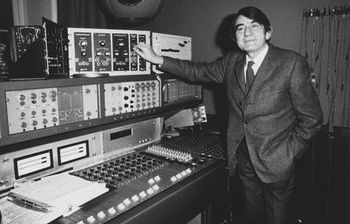
Pierre Schaeffer as a French composer, writer, broadcaster, engineer, musicologist and acoustician. He is most widely and currently recognised for his accomplishments in electronic and experimental music, at the core of which stands his role as the chief developer of a unique and early form of avant-garde music known as musique concrète.[4]
Music Concrète is a form of experimental music that exploits acousmatic listening, meaning sound identities can often be intentionally obscured or appear unconnected to their source cause. [5] Schaeffer realised there was a rich vein of musicality hidden within such seemingly mundane sounds: snippets of complex rhythms, unique timbral characteristics, tonal peculiarities, strange and interesting textures. Our perception of these qualities, he recognized, was hindered by the associations and references that sounds inherently carry. [6]
Today, Schaeffer is considered one of the most influential experimental, electroacoustic and subsequently electronic musicians, having been the first composer to utilize a number of contemporary recording and sampling techniques that are now used worldwide by nearly all record production companies.
Contemporary practitioners
When I was researching to figure out on which aspect of sound I could work, I came across with several musicians and artists inspired me. My focus was rather on composers and performers who are currently active.
Caterina Barbieri
Caterina Barbieri is a Berlin-based Italian composer who explores themes related to machine intelligence and object oriented perception in sound through a focus on minimalism. Using modular synthesisers as the main tool, she explores the psycho-physical effects of repetition and pattern-based operations in music, by investigating the polyphonic and polyrhythmic potential of sequencers to draw severe, complex geometries in time and space. Approaching music practice as an integrative cognitive feedback between humans and technology lies at the core of her current sonic research.[7] I found her practice relevant to me since she approaches sound as a medium to stimulate consciousness. Besides, the way she uses sound pattern to create the whole piece is very interesting because it shows the process of development of the very first elements. Her concept inspired me to use patterns and repetition in the sound piece in the effective way as I intended and gave me insight about minimalism in music and process music, in which the process is audible to the listener. These processes consist of specific systems of choosing and arranging notes through pitch and time, often involving a long-term progress with a limited musical materials. [8]
Tomoko Sauvage
Tomoko Sauvage is a Japanese musician and artist who investigates the sculpturality of sound and improvisation in relation to the environment. I found her during my research for the first trial, using water as analogue sound filter for the environment. She uses China bowls of different sizes, filled with water and amplified via underwater microphones. By doing so she made her own invented instrument, a natural synthesiser. The waterbowls work as a natural synthesiser that generates fluid timber using waves, drops, and bubbles. These elements resonate and also produce subaquatic feedback, an acoustic phenomenon that requires fine tuning depending on the amount of water, a subtle volume control and interaction with the acoustic space. Under the form of performances, installations and compositions, investigating the sound and visual properties of water in different states, as well as those of ceramics, combined with electronics. She searches for a fragile balance between randomness and discipline, chaos and order. [9] She is the artist who has been already exploring my primary research interest, combining water, sound and space with the element of electronics to manipulate the atmosphere.
Field Research/Events
While doing researches and working on the project, I visited several events, performances and exhibitions for inspirations and see how the relevant practices are held in real world. I think it is really important to visit and see these kinds of events as much as possible because it gives me an insight of the field which I cannot learn inside the school. I want to figure out in what kind of exhibition, event, performance I would be able to position myself after the study. By doing field research, I get to know people who are engaged in this field and involved organisations which I can potentially contact later on.
Ryoji Ikeda at EYE Museum
Event page: https://www.eyefilm.nl/en/exhibition/ryojiikeda
Image source: https://kunstmeisjes.com/2018/10/02/go-no-go-132-dansende-data-en-elektronische-bliepjes/
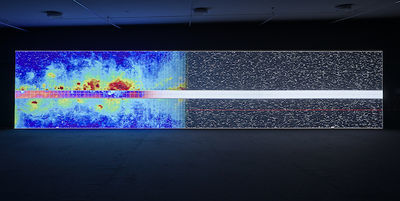
V2 Klankvorm #7
Event page: http://v2.nl/events/klankvorm-7
image source: https://www.facebook.com/events/151927015748358/?active_tab=discussion
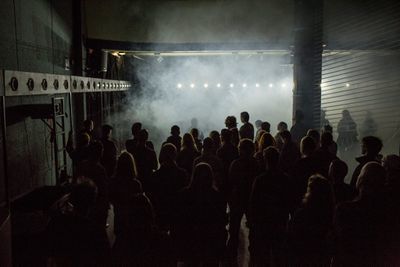
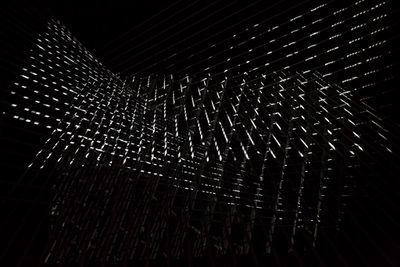
I am doing volunteer work in V2 and had a chance to do a shift during this event. I was interested in the organisation Klankvorm already from their concept and performance idea. There were 3 different commissioned performances which were specifically installed in V2 space.
Klankvorm is a Rotterdam-based platform for the realisation and presentation of experimental audiovisual art. Klankvorm events take place in different locations and feature audiovisual performances and related presentations. Klankvorm aims to initiate, commission and present new works together with sound artists and visual artists who collaboratively explore the audiovisual domain.
The Rest is Noise - Alva Noto
Event page: https://www.muziekgebouw.nl/agenda/8004/_object_blue_Valery_Vermeulen/Alva_Noto_UNIEQAV/
Image source: https://www.facebook.com/events/340189403221857/?active_tab=discussion
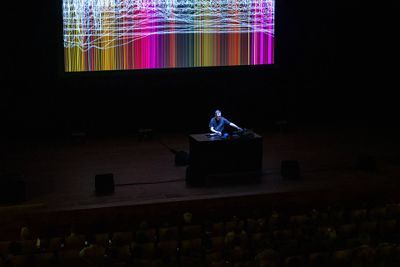
This event was part of FIBER weekends 2018, a new, decentralized art event dedicated to emerging developments in audiovisual art, electronic music, performances, creative coding, and advanced technologies. FIBER Weekends 2018 opens with a night of mesmerizing live performances at Muziekgebouw aan ‘t IJ on Friday, 23 November. Presented in collaboration with The Rest Is Noise, the opening concert sees pioneering German sound and visual artist Alva Noto unveil the Dutch premiere of his latest project, UNIEQAV, a live set by Beijing-born DJ and producer object blue, and a lecture-performance by Belgian electronic musician and mathematician Valery Vermeulen.I knew the record label Raster Noton and listened to the collaboration album by Alva Noto and Ryuichi Sakamoto. So I really wanted to see his performance since he was combining it with coded visual. It was held in Muziekgebouw aan ‘t IJ, in Amsterdam.
WORM Instruments Make Play
Event page: https://worm.org/production/instruments-make-play-2018/
Image source: https://www.facebook.com/events/471290653362501/?active_tab=discussion
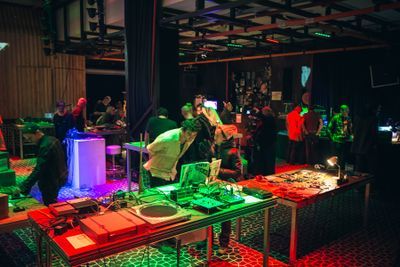
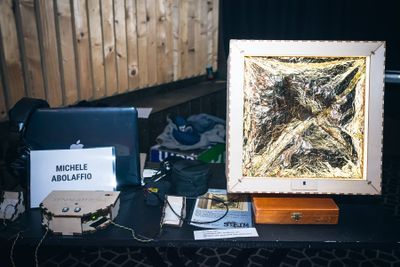
This event was very inspiring. There were many artists/musicians/hobbyists who made there own instrument and they were showcased as an exhibition form. There were performances of them playing their own stuffs. I got inspired to develop my work to my own DIY instrument/spatial installation.
https://worm.org/production/the-sound-of-ketelmuziek-10/
Experiments
I tried several things to be ended up with my final process. First I tried to make an analogue sound filter for the space. Second, I wanted to explore algorithmic composition with coding and combined with coded visual such as Processing. In the end, I decided to make an interface/installation.
Contact Microphone
As an extension from the second project, I wanted to try out if the contact underwater microphone would work as a water filter in our surroundings. I decided to make a hydrophone myself with two piezo elements and xlr mic cable.
I followed this instruction from instructables. I covered it with wax to make it more waterproof. The microphone worked well.

For the trial, I put it under the bucket as the former exercise, connected it to audio interface as input connected loud speakers for the output. However, it did not have the effect I wanted when I put it underwater. Because it only captured the sound from the physical contact, it was to clean and crisp for the atmospheric usage which I was imagining. I expected it to have delay, echo effects from the feedback loop of realtime sound input and the filtered output.
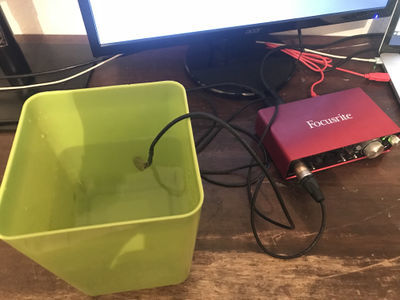
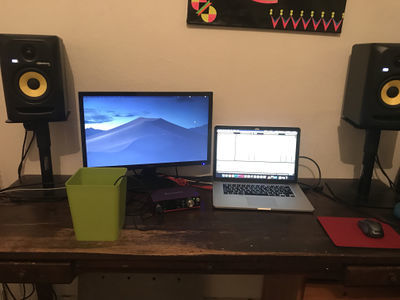
But then, I still wanted to try with some other audio effect using Ableton. I found that Resonator can work interesting with contact microphone[10]. It made some cool sound but I could not really come up with anything I can go further with this. I also found a very interesting project from an artist Joo Won Park, called Toccata using contact microphone and SuperCollider. From this, I wanted to research what SuperCollider is.
Synthesis, Algorithmic Composition
SuperCollider is an environment and programming language for real-time audio synthesis and algorithmic composition. It is an efficient and expressive dynamic programming language providing a framework for acoustic research, algorithmic music, interactive programming and live coding.[11] Algorave is an event where people dance to music generated from algorithms, often using live coding techniques. It has become a movement taking place around the world.[12] In Algorave, the live coding environment TidalCycles is often used, which produces sound via the SuperCollider sound environment through the SuperDirt framework, or via MIDI or Open Sound Control.[13]
Insights from Experimentation
The two experiments has been completely different approach. First idea was about using the existing sound around us and transforming it with water as an analogue filter, more natural, acoustic way without using programming. The second idea was about sound synthesis itself, especially in digital way with programming. I was really exited when I found the programming language SuperCollider, from the idea that I can code the sound and even composition. There were many interesting way to use this combining with other interactive elements and programmes. However, since I am fairly novice to programming and unintuitive interface for making sound and music, I gave up to use this programme for this project for efficiency issue. It is also because I didn't know that much about audio synthesis terms and elements. So I decided to move on to use Ableton again which I am bit more familiar with. But I really want to get back to learn SuperCollider at some point. The idea of Algorave, live coding party, is also very exciting. I missed one party at Utrecht but would really want to experience when it is held around me.
Process
Ableton Live
At the beginning I decided to make a composition with Ableton Live, a software music sequencer and DAW(Digital Audio Workstation), which is really good with sampling and playing around with musical ideas. I like when found sound was used as the musical sources, so I tried out some found sound beats.
Perception of Sound, pattern, repetition
Nowadays we are living in the age of mechanical reproduction and it somehow changed our perspective on beauty. Whenever I walk down the streets, I hear the noise of construction works such as drills, banging hammers that become repetitive in my head and suddenly become a rhythm and then music. I decided to make a drum machine interface where audiences can create their own beat from the found sounds. Then I wanted to visualise the patterns and repetition of the beats. I wanted to visualise it as a movement using motors. I thought this way of creating optical kinetic installation would be effective to show the mesmerising effect of the repetition of the patterns.
Found sound, audio edit, effect

First I did some field recordings and manipulated them in Ableton. Some of the found sound, I used it from freesound.org. I warped, transposed, and cropped the sound and put audio effects to recreate the sound. There were many audio effects I could apply from Ableton. Mostly I used reverb, ping pong delay, and sometimes frequency shifter, vocoder, etc. I put the recorded found sounds in the drum rack to use each elements as a percussion sound, such as kick, snare, hihat etc.
Mono Sequencer for Synth


I wanted to add some synth patterns as well to give the whole piece more musical, trippy touch and to represent it as paranoia in subconsciousness. First I used the analog, a software synthesiser instrument in Ableton to synthesise sound. This is subtract synthesis method, a very simple signal chain of an oscillator (sound source) running through a filter (EQ curve) which is then sent to an amplifier for gain staging and ADSR control.[14] I used a software instrument 16 step mono sequencer inside Ableton to create a random, trippy pattern. I could adjust how much I want to randomise the pitch, velocity, octave, duration, etc.
Technical aspects
Electronics
By using Max for Live connection kit, I could directly connect it to Arduino for inputs and outputs. I decided to use Servo motors because they are easy to control with Ableton and I thought the movements of motors and sound wave vibration matches to create the pattern and repetition in different forms. I was planning to use 12 to 16 servo motors to control each sounds. But I didn't know that I need extra power source to use more that several motors by using Arduino since it only provides 5V and they take a lot of electricity. It was recommended to use 5v 10A switching power supply for up to perhaps 16 servos.The easy way to use many servo motors with Arduino is using a shield. A shield for Arduino is sort of extension plug-in, which gives Arduino more functionalities. By googling, I decided to use this Adafruit 16 servo shield.
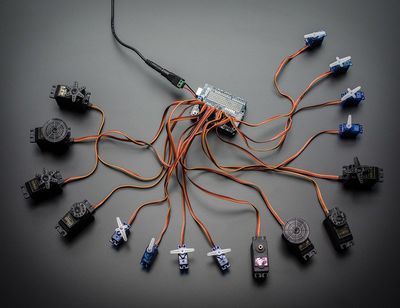
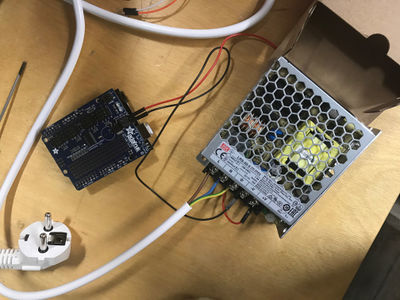
OSC
Open Sound Control (OSC) is a protocol for networking sound synthesisers, computers, and other multimedia devices for purposes such as musical performance or show control. OSC's advantages include interoperability, accuracy, flexibility and enhanced organisation and documentation. With Ableton Connection Kit, it is easy to control motors, LED, etc via Arduino. However, since I am planning to use 12 servo motors and using a shield for Arduino, the digital outputs have been changed. So Ableton could not read the shield. I asked Mike in interaction station for a help, and he suggested me to send OSC to Processing and connect it to Arduino.

Input - Output
I used TouchOSC software to control MIDI for Ableton Live. You can use mobiles and pads for this programme. It works with Wifi connection so I need to know the host IP of my laptop and connect it from the software with iPad. So when people touches certain button in iPad it sends the signal to Ableton, to the play the sound, and the sound is connected to each assigned servo motor as output. I made the interface in two pages. In the first page 'sound', each buttons are assigned to each sounds. In the second page 'pattern', each buttons are assigned to the sequence/pattern I already made. Each rows have different groups of sounds, therefore the first rows of patterns consist of first rows of sounds. I also added some parameters to control the audio such as bpm of the whole track and frequency, resonance, delay and volume of the synth.
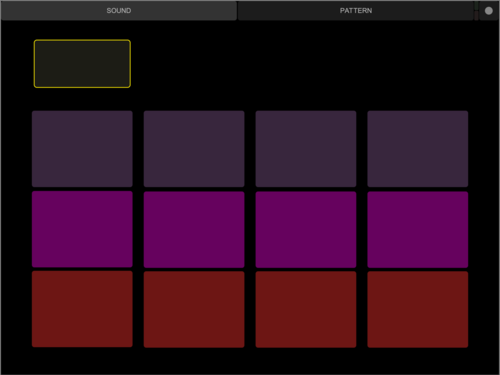
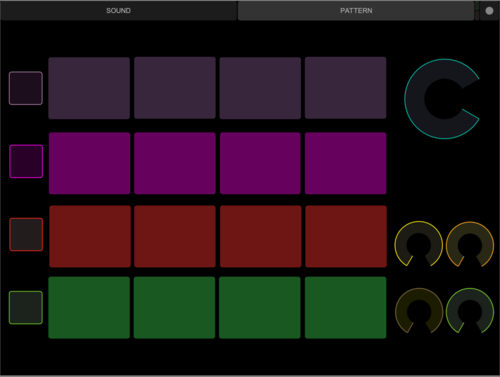
Material exploration/Visual aesthetics
Using metal was pretty intuitive decision for me since I have worked with metal for a while to make sculptures. I used to make bent, plasma cut, welded geometric steel sheet sculpture to demonstrate my notion of object and space and their relationship. I like the aesthetics of cold, sharp steel sheet. Therefore it was reasonable process for me to further work with it. This time it was used to as a base panel to support the motors, Arudino and all the electronics. The size is 600 x 600 mm. I put wire through the small holes on the servo arms because it is also metal and gives the line element to the plane elements, creating more spatial aspect. Also, when the servo motors move, the wire would scratch the surface of the metal sheet, might make some noise of tapping the metal sheet. Therefore, somehow it made sense to use it. Then I attached some scrap/found objects such as clips, tin can lid caps, nails, screws, partly from the same metallic aesthetics but also it matches to the sounds I use which are also found sound. I added some colour by attaching some paper tapes and painted them. These fluorescent colours came from my former works and they are also related to trippy elements for consciousness. I also made a headphone stand as a whole set.


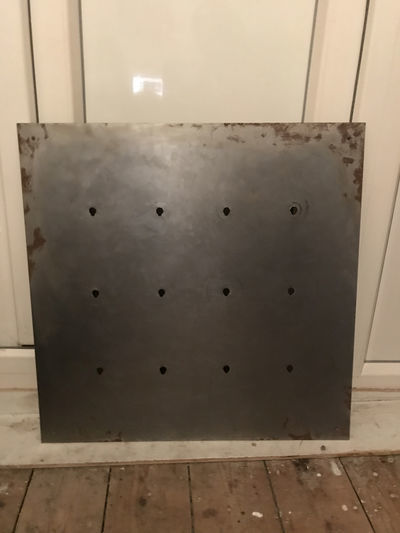
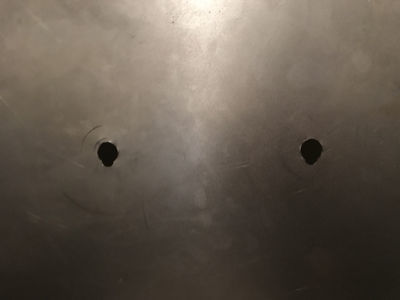
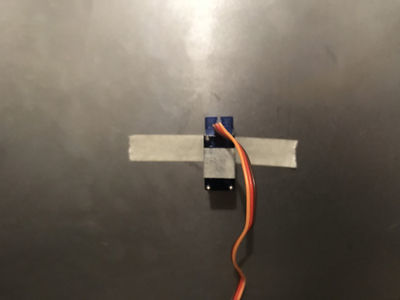
Realised work
Patterns of Consciousness
We are surrounded by sounds and noises everywhere,
yet not always conscious about it.
However when you start to be aware of them,
they scratch the surface of your consciousness.
They start to make patterns and repetitions,
forming a composition where your mind and consciousness trip inside.
Mesmerised by the patterns of the movements,
you reach to different states of mind.
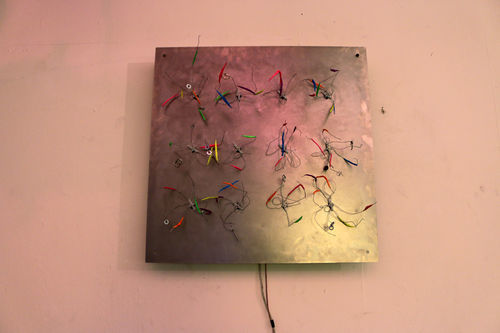
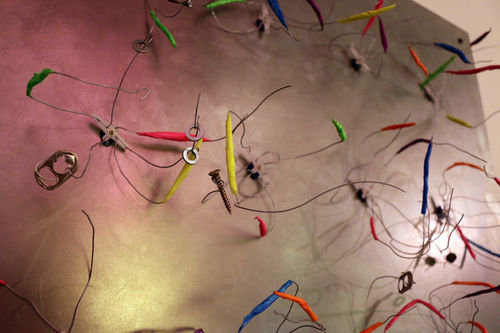
In the end, I made this phono-kinetic object which is controlled by input from an iPad. I made an interface as a whole, combining sound, touch and movement. The object is attached close to the wall, the typical way to display artwork. I wanted to experiment with the way of displaying, like just hang it somewhere in the air attached from the ceiling. However, since my work is in the transition of coming out of the wall as an art object, it made sense to hang it just on the wall and then implement the interaction via iPad, with people controlling in front of it. I put the iPad on the plinth in front of the object, and put a headphone next to it. So audiences control the iPad, listening and manipulating the sound.
Reflection
From the exhibition, I figured out that my work was quite self-explaining which worked in a good way. When people wore the headphone and touched the iPad, they realised the interaction between their touch, sound and the motor. And then they played with it for a while.
However, I think there should be some ways to enhance the whole experience with each elements as a whole. The sound from the headphone was of course my main purposed sound, but there was another sound coming from the movement of the motors and their scratches on the metal sheet. This was my intention to have as well but when the audiences wear the headphone, the two sounds are disconnected.
The interface for the audience input is quite minimally intuitive. However, I could have used each colours, shapes more relevant to the physical objects. Apart from that, I actually want to make another physical input device or environment, not with a touch pad.
Besides, this time I wanted to make a spatial installation, providing scenery rather than presenting an art object. Because it make more sense to create a spatial scenery merged into the exhibition space to make people aware/conscious of their surroundings. However, I feel like I couldn't break my pattern of presenting art objects in the end. I made an interface so people could be engaged in the installation, but it could be seen as controlling with a machine/object. I want to develop my practice into rather immersive larger scale to make a large scale spatial installation as performative set up or even doing performance myself.
Final Conclusion
There are several many ways I want to take from now on. Mostly, I want to improve the interactive sound installation with more spatially-merged quality with various elements. I would like to study circuit bending and sound generation technique with electronics in depth. By doing so, I could make my own instrument as well as an extension of the interactive sound installation. Besides, I want to research on spacetime-related aspect of sound so to be perceived more physical. For this aspect, I want to research on minimalism and process music. This will transform moment of the observation of work and the surrounding to fragment our consciousness. Besides, I will work on developing the interface to make it as a whole, providing it as a performative scene. At the same time I would like to try performance with my potential sound installation/instrument as well.
Bibliography
- ↑ https://en.wikipedia.org/wiki/Electroacoustic_music
- ↑ https://en.wikipedia.org/wiki/John_Cage
- ↑ https://en.wikipedia.org/wiki/Indeterminacy_(music)
- ↑ https://en.wikipedia.org/wiki/Pierre_Schaeffer
- ↑ https://en.wikipedia.org/wiki/Musique_concr%C3%A8te
- ↑ https://www.factmag.com/2016/02/23/pierre-schaeffer-guide/
- ↑ https://caterinabarbieri.com/
- ↑ https://en.wikipedia.org/wiki/Process_music
- ↑ https://o-o-o-o.org/about/
- ↑ https://www.macprovideo.com/article/ableton-live/have-fun-with-resonators-in-ableton-live/
- ↑ https://en.wikipedia.org/wiki/SuperCollider
- ↑ https://en.wikipedia.org/wiki/Algorave
- ↑ https://en.wikipedia.org/wiki/TidalCycles
- ↑ https://theproaudiofiles.com/sound-synthesis-basics/
